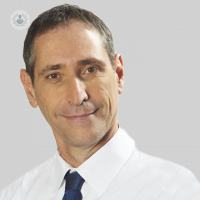Getting to grips with tennis elbow
Written in association with:Despite its name, tennis elbow is not just experienced by tennis players. In fact, tennis elbow, which is actually called lateral epicondylitis is a common condition caused by repetitive wrist extension and forearm supination movements. Over time, these movements cause micro-injuries to the tendons, resulting in what we know as tennis elbow. Mr Keith Adrian Borowsky, a leading shoulder and elbow surgeon, answers our questions about tennis elbow.

What causes tennis elbow?
Tennis elbow is caused by degenerative tearing of one of the tendons that inserts on the outside of the elbow. It can be precipitated by repetitive physical work but can also appear without this. It is a common condition and occupational factors with repetitive bending and straightening of the elbow are associated with the condition.
Almost all activities of daily living involve extending the wrist and in order to grasp effectively with one's fingers, wrist extension is essential. With this action the wrist extensor muscle contracts and the tendinous origin of the muscle at the elbow (where the degenerative tearing occurs) is under tension. This produces inflammation and pain which is usually maximal at the elbow itself, but typically also causes radiation pain down the arm as well.
What are the signs of tennis elbow?
The signs are pain and significant tenderness on the outside of the elbow, particularly when one grasps objects with one’s hand. It can become so severe that even simple tasks such as holding a telephone are painful.
There are also other causes of pain on the outside of the elbow that need to be considered, for example, wear and tear arthritis of the radial head, and following injuries, ligamentous instability can cause pain and clicking. These are both, however, rarer causes of elbow pain.
Can tennis elbow heal by itself?
The condition can heal by itself but this depends on the individual nature of one's tendons. Very minor tears may heal or tears may stop progressing with the resolution of symptoms. This process, however, may take 6-12 months.
How do you treat tennis elbow?
Simpler forms of treatment are rest, anti-inflammatories, passive stretching exercises and splints to decrease pull at the insertion point. If your case of tennis elbow is persistent, a cortisone injection can be given. Generally, up to three injections per year are considered acceptable if good periods of relief are obtained.
How long does it take to recover following treatment?
If conservative treatment is not working, then surgery is recommended and it does have a high success rate, but it does require a period of three months off heavy activity and sport. Hence, recovering from treatment does take months, but it can vary between patients.
To speak to a specialist about tennis elbow, make an appointment with an expert.



